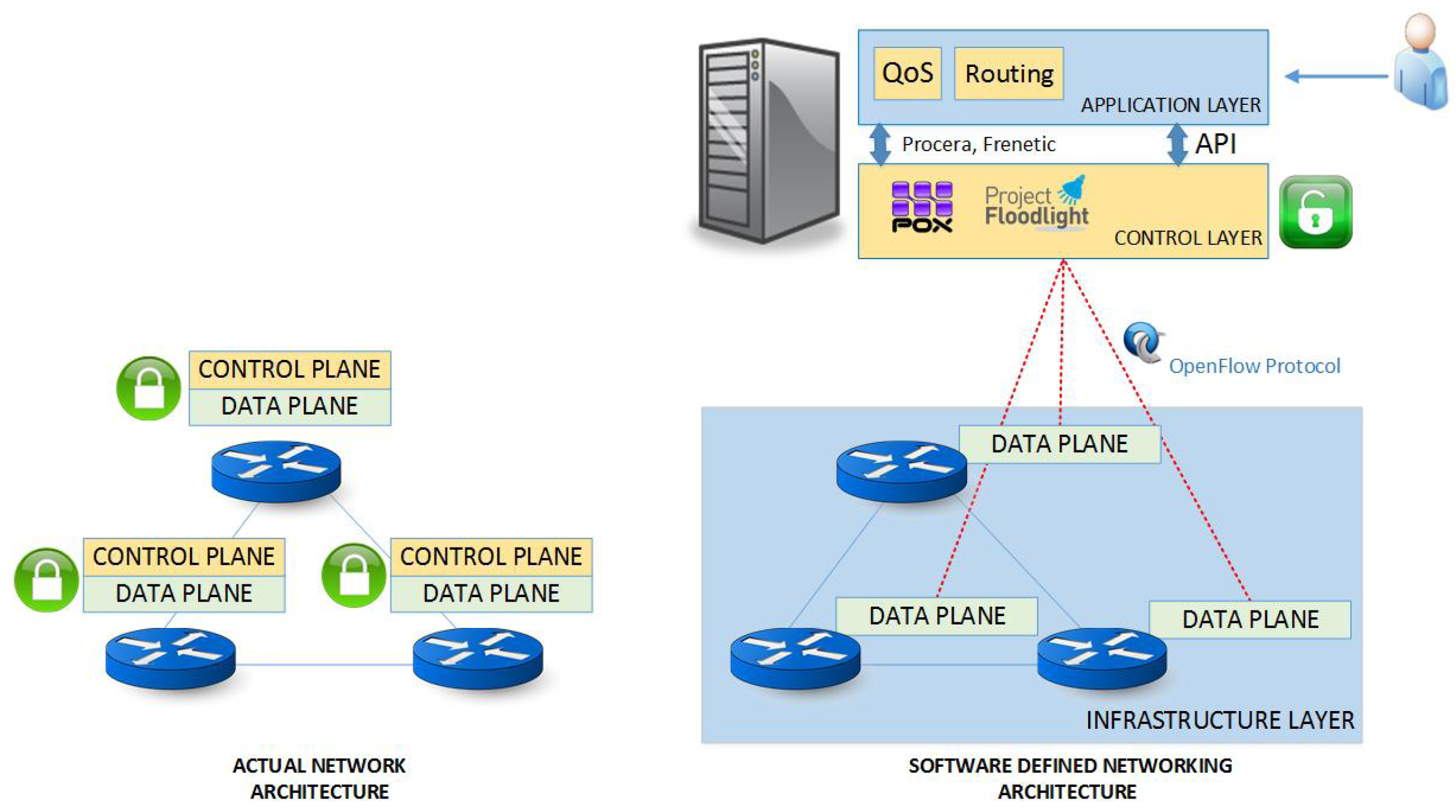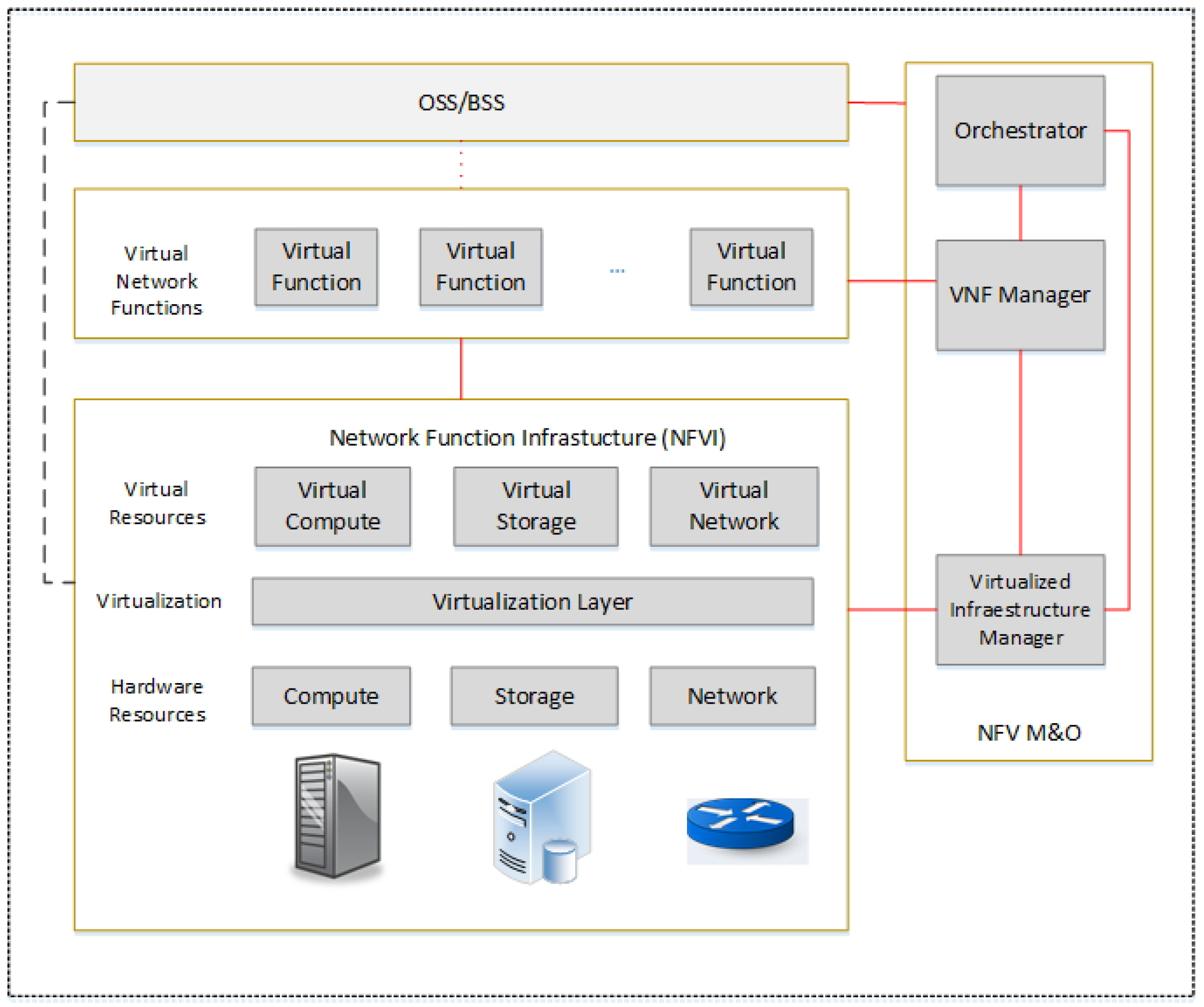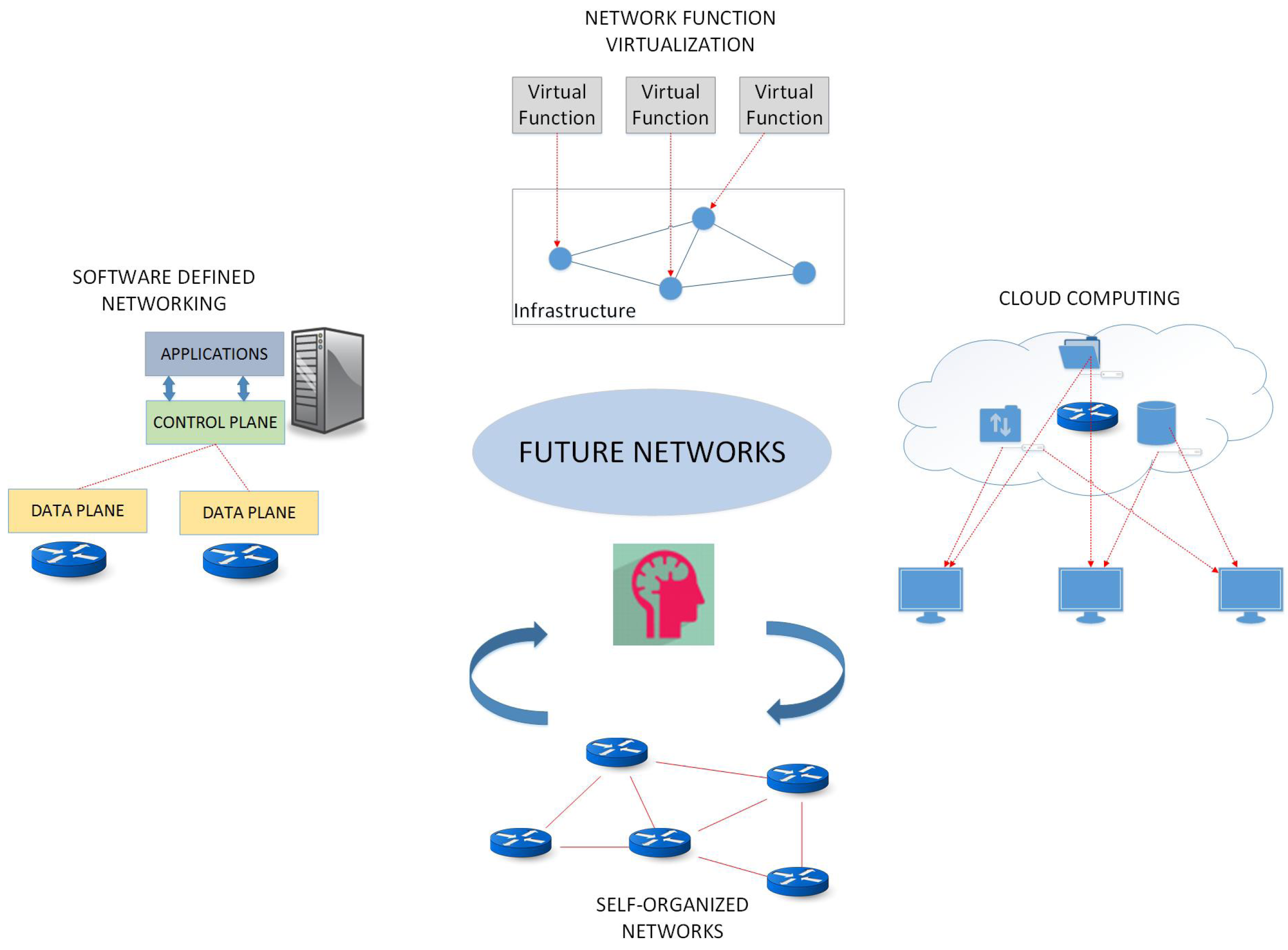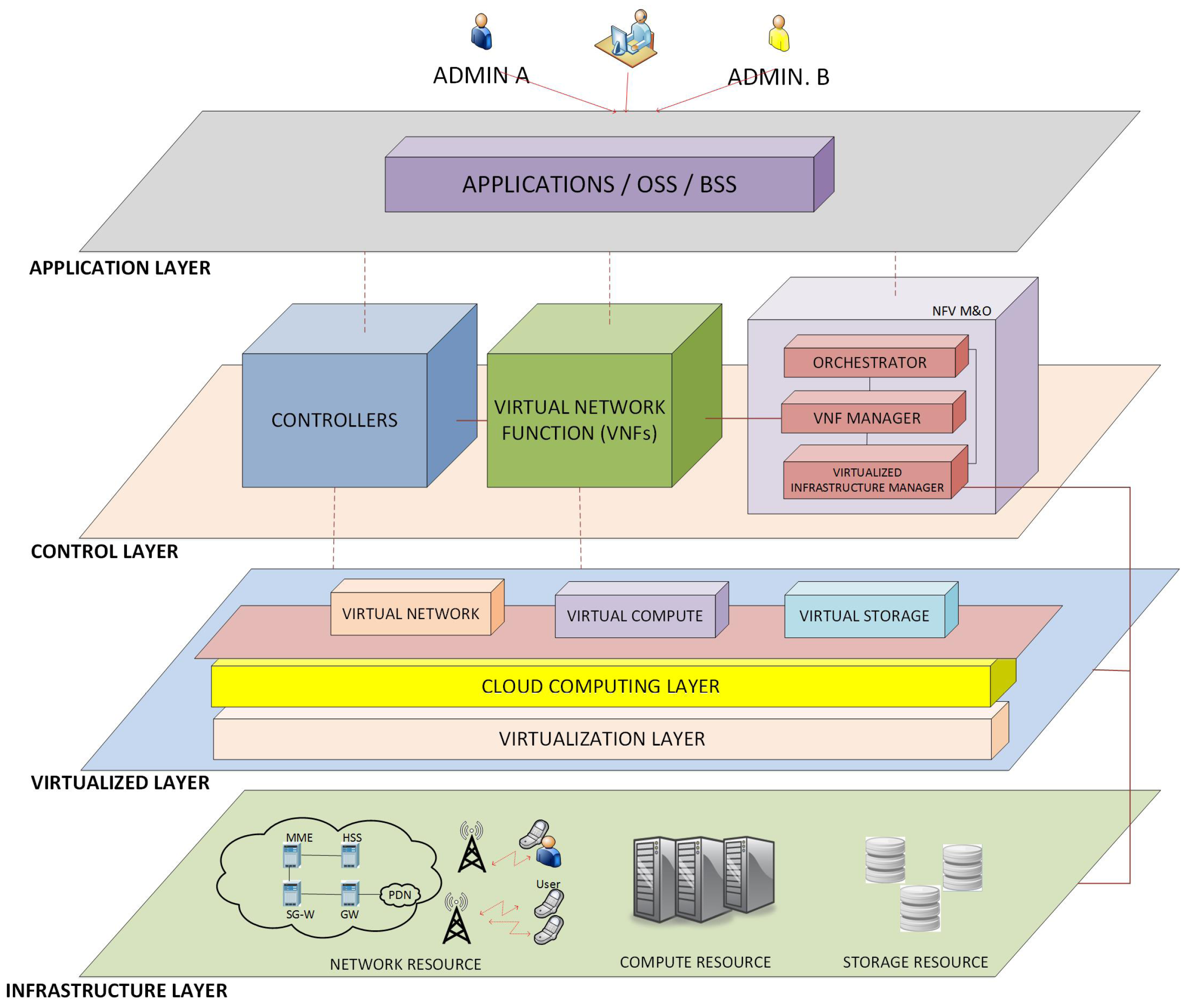Key Technologies in the Context of Future Networks: Operational and Management Requirements
Abstract
:1. Introduction
- Radio capabilities leverage the spectrum optimization, enhance interference coordination mechanisms and support dynamic radio topologies through the exploitation of higher frequencies, enabling cost-effective dense deployments, intelligent and dynamic coordination of multi Radio Access Technology (RAT), as well as sharing resources, among others.
- Network functionalities will enable the creation of an open environment in order to support several use cases in a cost-effective manner by means of the enhancement of user devices, minimizing the number of deployed entities and splitting the control and user plane functions (open its interfaces).
- The operation and management capabilities are intended to simplify operations not only in network control tasks but also in the deployment of new services, without increasing the system complexity. This field also includes reactive and proactive mechanisms to enhance the decision-making in control and management operations. This characteristic will enable the deployment of virtualized components, wherever they might be needed.
2. Key-Enabled Technologies for Future Networks
2.1. Software Defined Networking
2.2. Network Function Virtualization
2.3. Cloud Computing
2.4. Self-Organized Networks
3. Research Overview
4. Future Trends and Challenges
5. Conclusions
Acknowledgments
Author Contributions
Conflicts of Interest
References
- European Commission. Future Internet 2020: Visions of an Industry Expert Group 2009. Available online: http://www.future-internet.eu/fileadmin/documents/reports/FI_Panel_Report_v3.1_Final.pdf (accessed on 16 December 2016).
- Nokia Network. 5G Use Cases & Requirements. 2014. Available online: http://networks.nokia.com/file/31121/5g-requirements (accessed on 16 December 2016).
- Agyapong, P.K.; Iwamura, M.; Staehle, D.; Kiess, W.; Benjebbour, A. Design Considerations for a 5G Network Architecture. IEEE Commun. Mag. 2014, 52, 65–75. [Google Scholar] [CrossRef]
- NGMN Alliance. NMGN 5G White Paper 2015. Available online: https://www.ngmn.org/uploads/media/NGMN_5G_White_Paper_V1_0.pdf (accessed on 16 December 2016).
- Boccardi, F.; Heath, R.W.; Lozano, A.; Marzetta, T.L.; Popovski, P. Five Disruptive Technology directions for 5G. IEEE Commun. Mag. 2014, 52, 74–80. [Google Scholar] [CrossRef]
- Gupta, A.; Jha, R.K. A Survey of 5G Network: Architecture and Emerging Technologies. IEEE Access 2015, 3, 1206–1232. [Google Scholar] [CrossRef]
- Bangerter, B.; Talwar, S.; Arefi, R.; Stewart, K. Networks and Devices for the 5G Era. IEEE Commun. Mag. 2014, 52, 90–96. [Google Scholar] [CrossRef]
- Andrews, J.G.; Buzzi, S.; Choi, W.; Hanly, S.V.; Lozano, A.; Soong, A.C.; Zhang, J.C. What Will 5G Be? IEEE J. Sel. Areas Commun. 2014, 32, 1065–1082. [Google Scholar] [CrossRef]
- Demestichas, P.; Georgakopoulos, A.; Karvounas, D.; Tsagkaris, K.; Stavroulaki, V.; Lu, J.; Xiong, C.; Yao, J. 5G on the Horizon: Key Challenges for the Radio-Access Network. IEEE Veh. Technol. Mag. 2013, 8, 47–53. [Google Scholar] [CrossRef]
- Kreutz, D.; Ramos, F.M.V.; Verissimo, P.E.; Rothenberg, C.E.; Azodolmolky, S.; Uhlig, S. Software-defined Networking: A Comprehensive Survey. Proc. IEEE 2015, 103, 14–76. [Google Scholar] [CrossRef]
- ETSI Industry Specification Group (ISG). Network Function Virtualization (NFV) Architectural Framework. 2013. Available online: http://www.etsi.org/technologies-clusters/technologies/nfv (accessed on 16 December 2016).
- Zhang, Q.; Cheng, L.; Boutaba, R. Cloud Computing: State-of-the-art and Research Challenges. J. Int. Ser. Appl. 2010, 1, 7–18. [Google Scholar] [CrossRef]
- Baldo, N.; Giupponi, L.; Mangues-Bafalluy, J. Big Data Empowered Self Organized Networks. In Proceedings of the 20th European Wireless Conference, Barcelona, Spain, 14–16 May 2014.
- Buda, T.S.; Assem, H.; Xu, L.; Raz, D.; Margolin, U.; Rosensweig, E.; Lopez, D.R.; Corici, M.I.; Smirnov, M.; Mullins, R.; et al. Can Machine Learning aid in delivering new Use Cases and Scenarios in 5G? IEEE Netw. Oper. Manag. Symp. (NOMS) 2016, 1279–1284. [Google Scholar] [CrossRef]
- Mijumbi, R.; Serrat, J.; Gorricho, J.L.; Bouten, N.; Turck, F.; Boutaba, R. Network Function Virtualization: State-of-the-art and Research Challenges. IEEE Commun. Surv. Tutor. 2015, 18, 236–262. [Google Scholar] [CrossRef]
- Contreras, L.M.; Doolan, P.; Lonsethagen, H.; López, R. Operational, Organizational and Business Challenges for Network Operators in the context of SDN and NFV. Comput. Netw. 2015, 92, 211–217. [Google Scholar] [CrossRef]
- Hu, F.; Hao, Q.; Bao, K. A Survey on Software-Defined Network and OpenFlow: From Concept to Implementation. IEEE Commun. Surv. Tutor. 2014, 16, 1–27. [Google Scholar] [CrossRef]
- McKeown, N.; Anderson, T.; Balakrishnan, H.; Parulkar, G.; Peterson, L.; Rexford, J.; Shenker, S.; Turner, J. OpenFlow: Enabling Innovation in Campus Networks. ACM SIGCOMM Comput. Commun. Rev. 2008, 38, 69–74. [Google Scholar] [CrossRef]
- Sefraoui, O.; Aissaoui, M.; Eleuldj, M. OpenStack: Toward an Open-source Solution for Cloud Computing. Int. J. Comput. Appl. 2012, 55, 38–42. [Google Scholar] [CrossRef]
- Sonkoly, B.; Németh, F.; Csikor, L.; Gulyás, L.; Gulyás, A. SDN Based Testbeds for Evaluating and Promoting Multipath TCP. In Proceedings of the 2014 IEEE International Conference on Communications (ICC), Sydney, Australia, 10–14 June 2014; pp. 3044–3050.
- Pentikousis, K.; Wang, Y.; Hu, W. MobileFlow: Toward Software-defined Mobile Networks. IEEE Commun. Mag. 2013, 51, 44–53. [Google Scholar] [CrossRef]
- EU CROWD Project. Connectivity Management for EneRgy Optimised Wireless Dense Networks. Project Reference: 318115. Funded under: FP7–ICT. Available online: http://www.ict-crowd.eu/ (accessed on 16 December 2016).
- Abdelwahab, S.; Hamdaoui, B.; Guizani, M.; Znati, T. Network Function Virtualization in 5G. IEEE Commun. Mag. 2016, 54, 84–91. [Google Scholar] [CrossRef]
- Open Networking Foundation (ONF), 2016. Available online: https://www.opennetworking.org/ (accessed on 16 December 2016).
- ETSI Industry Specification Group (ISG). Network Function Virtualization Use Cases 2013. Available online: http://www.etsi.org/deliver/etsi_gs/nfv/001_099/001/01.01.01_60/gs_nfv001v010101p.pdf (accessed on 16 December 2016).
- Open Platform for NFV (OPNFV). Available online: https://www.opnfv.org/ (accessed on 16 December 2016).
- Floodlight SDN Controller. Available online: https://github.com/floodlight/floodlight (accessed on 16 December 2016).
- OpenDaylight SDN Controller. Available online: https://www.opendaylight.org/start (accessed on 16 December 2016).
- 5G Infrastructure Public Private Partnership - 5G PPP. Available online: https://5g-ppp.eu (accessed on 16 December 2016).
- IMT–2020 (5G) Promotion Group. Available online: http://www.imt-2020.cn/en/introduction (accessed on 16 December 2016).
- 5G Forum. Available online: http://www.5gforum.org/ (accessed on 16 December 2016).
- Fifth Generation Mobile Communication Promotion Forum (5GMF). Available online: http://5gmf.jp/en/ (accessed on 16 December 2016).
- Osseiran, A.; Boccardi, F.; Braun, V.; Kusume, K.; Marsch, P.; Maternia, M.; Queseth, O.; Schellmann, M.; Schotten, M.; Taoka, H.; et al. Scenarios for 5G Mobile and Wireless Communications: The Vision of the METIS Project. IEEE Commun. Mag. 2014, 52, 26–35. [Google Scholar] [CrossRef]
- MCN Project. Funded under: FP7-ICT. Project Reference: 318109, Funded under: FP7–ICT. Available online: http://www.mobile-cloud-networking.eu/site/ (accessed on 16 December 2016).
- CONTENT Project. Convergence of Wireless Optical Network and iT rEsources iN SupporT of Cloud Services. FP7-ICT. Project Reference: 318514, Funded under: FP7–ICT. Available online: http://cordis.europa.eu/fp7/ict/future-networks/documents/call8-projects/content-factsheet.pdf (accessed on 16 December 2016).
- EU T-NOVA Project. Network Functions as-a-Service over Virtualised Infrastructures. Project Reference: 619520. Funded under: FP7–ICT. Available online: http://www.t-nova.eu/ (accessed on 16 December 2016).
- EU UNIFY Project. Unifying Cloud and Carrier Networks. Project Reference: 619609. Funded under: FP7–ICT. Available online: http://www.fp7-unify.eu/ (accessed on 16 December 2016).
- 5G-NORMA Project. 5G NOvel Radio Multiservice Adaptive Network Architecture. Project Reference: 671584. Funded under: H2020-ICT-2014-2. Available online: https://5gnorma.5g-ppp.eu/ (accessed on 16 December 2016).
- METIS-II Project. Mobile and Wireless Communications Enablers for Twenty-Twenty (2020) Information Society-II. Project Reference: 671680. Funded under: H2020-ICT-2014-2. Available online: https://5g-ppp.eu/metis-ii/ (accessed on 16 December 2016).
- CHARISMA Project. Converged Heterogeneous Advanced 5G Cloud-RAN Architecture for Intelligent and Secure Media Access. Project Reference: 671704. Funded under: H2020-ICT-2014-2. Available online: http://www.charisma5g.eu// (accessed on 16 December 2016).
- SONATA Project. Service Programing and Orchestration for Virtualized Software Networks. Project Reference: 671517. Funded under: H2020-ICT-2014-2. Available online: http://www.sonata-nfv.eu// (accessed on 16 December 2016).
- Flex5Gware Project. Flexible and Efficient Hardware/Software Platforms for 5G Network Elements and Devices. Project Reference: 671563. Funded under: H2020-ICT-2014-2. Available online: http://www.flex5gware.eu/ (accessed on 16 December 2016).
- Neves, P.; Calé, R.; Costa, M.R.; Parada, C.; Parreira, B.; Alcaraz-Calero, J.; Wang, Q.; Nightingale, J.; Chirivella-Perez, E.; Jiang, W.; et al. The SELFNET Approach for Autonomic Management in an NFV/SDN Networking Paradigm. Int. J. Distrib. Sens. Net. 2016, 2016, 1–17. [Google Scholar] [CrossRef]
- SELFNET Project. Framework for Self-Organized Network Management in Virtualized and Software Defined Networks. Project Reference: 671672. Funded under: H2020-ICT-2014-2. Available online: https://selfnet-5g.eu/ (accessed on 16 December 2016).
- Xu, L.; Assem, H.; Yahia, I.G.B.; Buda, T.S.; Martin, A.; Gallico, D.; Biancani, M.; Pastor, A.; Aranda, P.A.; Smirnov, M.; et al. CogNet: A Network Management Architecture Featuring Cognitive Capabilities. IEEE Netw. Commun. (EuCNC) 2016, 2016, 325–329. [Google Scholar]
- 5G Americas, 2016. Available online: http://www.5gamericas.org/es/ (accessed on 16 December 2016).




| Project Name | Related Technologies | Main Objective | Scenarios/Use Cases |
|---|---|---|---|
| MCN [34] | • SDN • Cloud Computing | Enhanced traffic processing by means of the separation between radio hardware and packet forwarding hardware. | • Cloud Computing for Mobile Network Operations • End-To-End Mobile Cloud |
| T-NOVA [36] | • SDN • NFV | Design and implementation of an integrated architecture for the automated provision and management of VNF infrastructures. | • High-Level Scenario • VNFs • Service chaining |
| UNIFY [37] | • SDN • NFV | The development of an automated and dynamic service provision platform, based on a service chaining architecture | • Infrastructure Virtualization • Flexible Service Chaining • Network Service Chain Invocation for Providers |
| CROWD [22] | • SDN • SON | The creation of technologies to support dynamic network functionality configuration and fine, on-demand, capacity tuning. | General scenario |
| 5G-NORMA [38] | • SDN • NFV | The development of an adaptive, customizable, secure and efficient mobile network architecture to deal with complex traffic demand fluctuations. | • Multi-service • Multi-tenancy |
| CHARISMA [40] | • SDN • NFV | The creation of an intelligent and hierarchical routing and paravirtualized architecture to enhance end-to-end services. | General scenario |
| SELFNET [44] | • SDN • NFV • SON • Cloud | The design and implementation of an autonomic network management framework to achieve self-organizing capabilities in managing 5G network infrastructures, leveraging an improvement in the overall user experience. | • Self-healing • Self-protection • Self-optimization |
| COGNET [45] | • SDN • NFV • Machine Learning | Dynamic adaptation of the network resources (virtual network functions), while minimizing performance degradations and fulfill SLA requirements. | • Situational Context • Just-in-time Services • User-Centric Services • Optimized Services • SLA Enforcement • Collaborative Resource Manage |
| Requirement | Challenge | Future Trends/Enabler Technologies |
|---|---|---|
| System Performance | • Provide efficient mechanisms regarding to radio resource provisioning. • Improving the capacity of radio resources. • Provide super wide bandwidth. • Better management of data traffic, interference and mobility levels. | • Evolution of radio-access technologies (RATs). • Decreasing the cell size. • Millimeter-wave communication • Intelligent resource allocation via SDN or SON. |
| Composite Wireless Infrastructures | The 5G device can choose the most appropriate wireless or mobile technology according their needs (Change between systems). | • Enhancement of user devices (Muti-Band-Multi-Mode support). • Introduction of intelligent mechanisms and SDN control. |
| Facilitating very dense deployments (Hetnets) | Operators must provide effective mechanisms to deploy cells of different sizes according to user needs. | • Improving the resource capacity through decreasing the cell size. • Introduction of intelligent and Software Defined Radio (SDR) concepts. |
| Flexible spectrum management | Improve the spectrum utilization in order to operate in some spectrum bands or channels, while reducing interferences. | • Massive MIMO • Mechanisms to use unused bands. |
| Native support D2D Communication | Deploy networks based on interconnected end user devices (machines, sensors, etc). The traffic will be properly assigned without cause congestions. | • Introduction of Cognitive Intelligent mechanisms to exchange traffic between users. • Smarter end-user devices. |
| Reduce Capex and Opex | • Reduce the average service creation. • Dynamic scalability and deployment of services and NFs, while reducing the complexity in planning and configuration tasks. | • Resource sharing (Exploring Cloud-RAN, Cloud computing, NFV) • Smarter allocation of functional mobile components (SDN, NFV). |
| Muti-tenancy and multi–service support | Service providers can control the resources deployed in a shared infrastructure (network, computing, mobile resources). | • Cloud computing • SDN • NFV • Mobile Edge Computing (MEC) |
| Open Environment | New applications and NFs could be deployed in an open environment, regardless of the network hardware and technologies used by operators. | • Standardization of SDN and NFV concepts. • Introduction of SDR. |
| Energy efficiency operation | Saving energy per service provided. Nowadays, most of the energy consumption comes from RAN elements. | Introduction of intelligent and SON capabilities taking into account the device status. |
| Monitoring and Management | Provide self-management and self-optimization capabilities to 5G systems. | • Automated management and monitoring functions (SDN, NFV). • Takes decisions based on historical record of network status. |
| Ensuring QoS/ QoE and SLA | A 5G user will be able to obtain enhanced services, regardless of the location or network technologies (compared with 4G systems), for several use cases such as emergency situations or network failures. | • Enhanced mechanism to monitor the network status (traffic optimization techniques) via SDN and intelligent mechanism. • Automated network configuration to ensure the required need (SDN, NFV). |
| Charging and billing | Create different user profiles so that customers pay only the required service (pay-as-you-go), while operators bill the respective service. | Introduction of SDN and NFV concepts. |
© 2016 by the authors. Licensee MDPI, Basel, Switzerland. This article is an open access article distributed under the terms and conditions of the Creative Commons Attribution (CC BY) license ( http://creativecommons.org/licenses/by/4.0/).
Share and Cite
Barona López, L.I.; Valdivieso Caraguay, Á.L.; Sotelo Monge, M.A.; García Villalba, L.J. Key Technologies in the Context of Future Networks: Operational and Management Requirements. Future Internet 2017, 9, 1. https://doi.org/10.3390/fi9010001
Barona López LI, Valdivieso Caraguay ÁL, Sotelo Monge MA, García Villalba LJ. Key Technologies in the Context of Future Networks: Operational and Management Requirements. Future Internet. 2017; 9(1):1. https://doi.org/10.3390/fi9010001
Chicago/Turabian StyleBarona López, Lorena Isabel, Ángel Leonardo Valdivieso Caraguay, Marco Antonio Sotelo Monge, and Luis Javier García Villalba. 2017. "Key Technologies in the Context of Future Networks: Operational and Management Requirements" Future Internet 9, no. 1: 1. https://doi.org/10.3390/fi9010001






